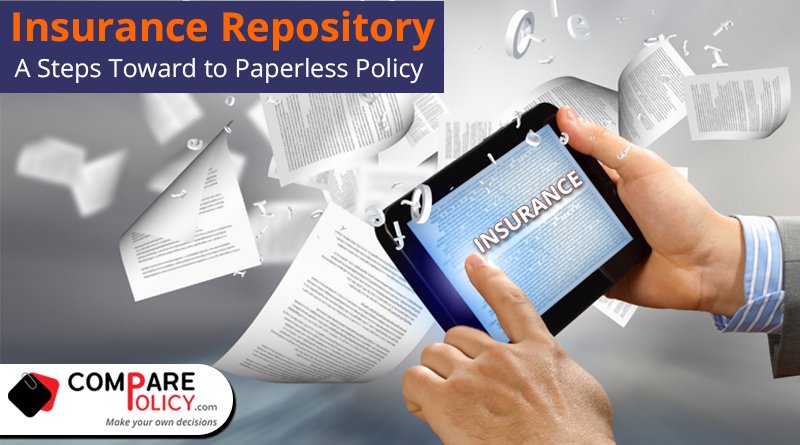Insurance Repository: A Step Toward to Paperless Policy
With the advancement of information technology, it was the turn of the insurance sector to go digital like others. Facilities to keep policies in electronic format along with various online services had been sought for a long time in India. In 2013, the Insurance Regulatory and Development Authority of India (IRDAI) brought Insurance Repository System (IRS); the first of its kind in India with a view to bringing transparency in the sector along with providing services at a click of the mouse.
Insurance Repositories are companies formed and registered with the insurance regulator under the Companies Act, 1956 for maintaining data of insurance policies whether it’s life or non-life in digital form on behalf of insurance companies. With any of the licensed insurance repositories, policyholders can keep their policies in an Electronic Insurance Account (EIA).
So far, the IRDAI has licensed five entities to operate their businesses as insurance repositories. These are – Central Insurance Repository Limited, NSDL Database Management Limited, Karvy Insurance Repository Limited, CAMS Repository Services Limited, and SHCIL Projects Limited.
With this move, over 25 crore policyholders having policies of about 37 crores, can avail the benefits of keeping their e-insurance in a phased manner. With the opening of an electronic account, policyholders will not require to keep paper documents.
Table Content
What is an e-Insurance Account (e-IA)?
A Demat account that facilitates policyholders to access and manage their policies online either bought as a physical policy or e-policy. To buy and keep policies in electronic mode, policyholders will need to open an electronic insurance account with any of the Insurance Repositories. Policyholders can buy and keep all kinds of policies be it Health insurance, Term insurance, Motor insurance, Pension plan, or any other policies in a single EIA, they don’t need to open a separate account for separate policies irrespective of insurers. Each policyholder, after getting an EIA opened, receives a unique user id and password using which they can log in to the respective repository website to access their accounts.
Benefits of keeping policies in an e-IA
Unlike physical policies, there is no fear of losing or being damaged by policies from different insurance companies in a single electronic account that enables policyholders to view and manage their policies online on the go. They don’t need to go to the offices of different insurers. Because of its single-point service feature and data available online, altering of details such as – address, nominee name, etc. has become simple, faster, and more reliable.
After you make changes, your repository notifies all relevant insurance companies. It would also help curb the mis-selling of insurance policies.
kept in an electronic account. You can keep all insurance policies issued from
How can One Buy a Policy after having an Electronic Account?
Since a policyholder has already submitted all KYC documents to the repository at the time of opening the EIA and has been verified, he/she don’t require to submit such documents again while buying a policy. Thus, buying insurance policies in electronic form becomes simpler. The buyer only needs to specify his/her unique electronic account number in the application. The respective insurance provider soon issues a policy, and it is reflected in the policyholder’s EIA.
The Workings
The IRDA has licensed five different organizations – NSDL Database Management, Central Insurance Repository, SHCIL Projects, Karvy Insurance Repository, and CAMS Repository Services – to act as Insurance Repository (IR). This means that you can communicate with these five organizations for e-insurance, from these companies you will be given the facility to open an e-insurance account (EIA), which will keep all your information and policies in electronic form. Will keep The policyholder will not have to pay any charges, as the cost will be borne by the insurer.
If sources are to be believed, in the initial phase of e-insurance, this facility was available only for individual life insurance policies. But with the passage of time, this will be extended to other life insurance and non-life policies as well, you have three options to open an account: You can directly contact one of the five repositories, send the request through your can route. Enlisting the services of a ‘sanctioned person’ appointed by the insurance company or repository.
You will have to complete a form to open an e-insurance account and in addition, you will also have to give your canceled cheque, submit your photograph, along with your address proof and KYC documents like (either Aadhaar or PAN card). One thing you should know is that you cannot open more than one Demat account, as IRDA allows only one e-insurance account per person and this rule has to be followed by everyone.
Conclusion
Making the future our first choice should be within all of us, only then we will take everything as a new experience, e-insurance is also an important part of our coming future and its being electronic only confirms this. Digitization has given a new dimension to India and Indian services, and somewhere with the help of the internet, things have become easy and time-saving for people. Insurance Repository: A Step Toward to Paperless Policy means now on an insurance company providing you a better platform for policy and also making things easy for you with using a proper amount of time.

